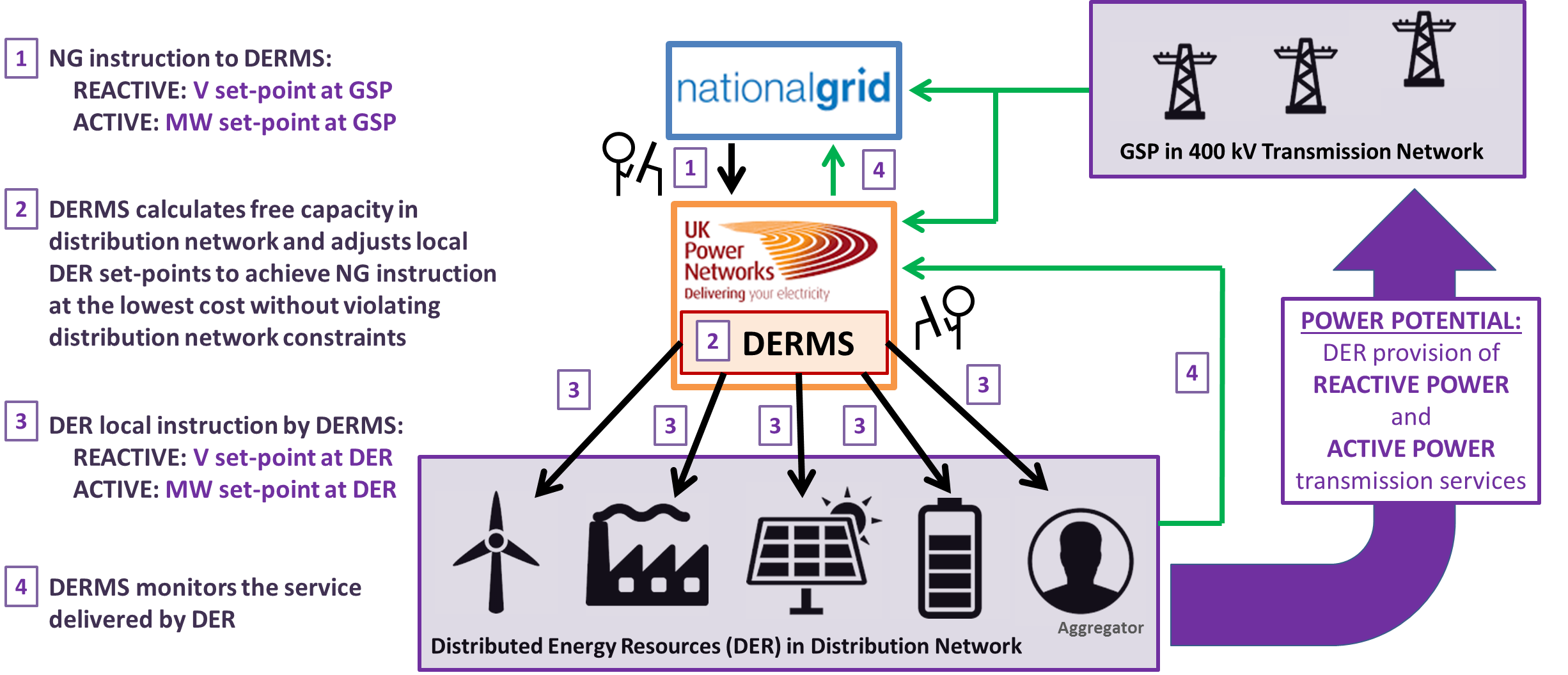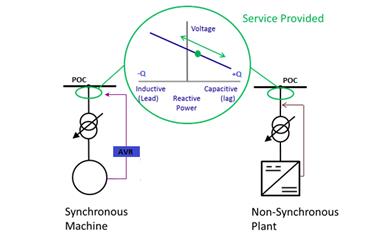Power Potential is a ground-breaking collaboration between National Grid ESO (NGESO), UK Power Networks and generators on the south coast distribution network.
Through the Power Potential project, we have demonstrated a world-first regional reactive power market in a live system trial. We have also verified the principles of a transmission and a distribution system operator enabling Distributed Energy Resources (DER) on the distribution network to deliver dynamic voltage control for transmission constraints. Crucially this has been integrated with operational systems, rather than merely being a proof-of-concept.
The expansion of Power Potential as a dynamic service as trialled, could save energy consumers over £96m by 2050 when rolled out to 19 (out of 36) transmission voltage zones within Great Britain. However, all transmission zones have some dynamic requirement. If the solution were being replicated to more regions, the total benefits could be even higher.
Power Potential Project is now completed and we wish to thank everyone involved to make this a successful project.
Throughout Great Britain, distribution power networks have been experiencing increased levels of renewable generation such as wind and solar, etc. As this trend continues to increase, more coordination between the Great Britain (GB) System Operator and distribution network operators (DNOs) is needed. This will increase system flexibility by using more DER capabilities and provide network support at a distribution and transmission level.
The three-year study is based in the South East region of the UK, where the connection of distributed energy resources is growing rapidly. Given the region’s location there is also high interconnection with continental Europe with HVDC links of 2GW, increasing to 5GW with future projects.
Understand the Power Potential project in 2 minutes
Duncan Burt, Director of Operations, National Grid ESO explains the project in more detail
"The Power Potential project is an exciting opportunity for Innogy to further utilise existing resources to better support balancing the local & transmission network. We look forward to playing an important role and developing new solutions to the changing world and requirements for balancing the electricity network of the future."
Nathan Evans, Commodity Analyst at Innogy.
Power Potential final showcase virtual event 2021 and Close Down Report
UK Power Networks and National Grid ESO were delighted to present to you the Power Potential final showcase virtual event on Thursday 24 June 2021. The slides are now available in the Conference Archive section within Related Documents. You can watch a video of the event by clicking on the play button in this banner.
Why Power Potential?
As renewables replace synchronous generation, there are challenges to the management of supply including:
- high voltage in periods of low demand
- low voltage under certain fault conditions
- thermal constraints during the outage season.
As a result, there are constraints on the numbers of low carbon technologies that can connect in the South East region of the UK as well as a high risk of operational issues in the network and a high cost of managing those issues.
National Grid and UK Power Networks have a shared vision for a more open and participatory power network.
The objective of the project is to create a regional reactive power market for distributed energy resources (DER) connected to the distribution network to provide the following services to the Great Britain (GB) System Operator:
- dynamic voltage control form DER (Mvar for high and low voltage conditions)
- active power support for constraint management and system balancing
In order to provide voltage support in South East, increasing reactive compensation is needed. DER connected in the distribution network have the potential to provide reactive and active power services to the system.
Giving us access to resources connected in UK Power Network’s South East network will provide additional tools for managing voltage transmission constraints. It will also open up new revenue streams for distributed energy resources by opening up a new market for them.
Power Potential is structured into the following key deliverables:
- a commercial framework using market forces to create new services from distributed energy resources to National Grid via UK Power Networks
- a platform known as Distributed Energy Resources Management System (DERMS) to support technical and commercial optimisation and dispatch.
The DERMS solution will work as follows:
- gather commercial availability, capability and costs from each DER
- run power flow assessments to calculate the possible availability of each service at the grid service point and present that information to us
- instruct each DER to change their set–point as required and monitor their response on the day power is required by us.
If successful Power Potential could potentially save up to £412m for UK consumers by 2050. It could be introduced to 59 other transmission sites and produce an additional 3,720 MW of generation in the South East area by 2050.
More details on the project can be found on Ofgem's website.
Requirements for participation
The following generators/plants connected in the South East area of England are encouraged to participate in the Power Potential trial:
- PV power plants.
- Wind farms.
- Batteries and storage sites.
- Synchronous generators.
- Aggregators.
- Other distributed energy resources (DER) not reflected in this list.
If you have any of the above generation connected in the South East, we’d like to hear from you. If you are outside of this scope, we would welcome your feedback on our design and invite you to keep abreast of the ongoing work in developing the reactive market on our website.
Before deciding to take part in the trial there are a number of points you may need to consider. They are:
- What are the services to be provided through Power Potential?
- How do I know if my plant is suitable?
- Do I need to make any changes to my plant to take part?
- What are the next steps?
During 2018, we will design and test the technical and commercial design of the Power Potential project with trial participants. The trial will take place in 2019 and will only be open to distributed energy resources (DER) connected via UK Power Networks, at Canterbury, Sellindge, Bolney and Ninfield. Unfortunately, if your assets are outside of this area you will be unable to participate in the one year trial.
We'll be seeking feedback and ideas during the trial from the wider industry through our Regulatory Market Advisory Panel.
The trial is investigating whether reactive power support from non-conventional sources are only effective if they are connected to the transmission system at 400/275 kV. If they are connected to the distribution system, their level of effectivness will be investigated.
This work forms part of the deliverables of the Flexibility workstream, which is looking at how we improve and simplify balancing services. In 2017 we published a System Needs and Product Strategy document which sets out how we intend to review and simplify balancing services.
The document sets out how we intend to reassess the commercial valuation of reactive power and consider locational sensitivities. This will look at clearer signals of need, appropriate routes to market for potential providers and how we can access reactive power from generation when at low, or no active power output.
We would like to create a market that values reactive power in a transparent manner and aim to do this by the end of 2018/19. This design will begin following consultation and will also be informed by the results of the Power Potential project.
Events and news
Power Potential final showcase virtual event was held on Thursday 24th June 2021
UK Power Networks and National Grid ESO were delighted to present to you the Power Potential final showcase event.
The project team had analysed and compiled the trials’ technical performance, commercial results, key insights and next steps for the project. The event featured speakers from both National Grid ESO and UK Power Networks and an extended Q&A so the audience could put questions to our experts.
The slides are now available in the Conference Archive section within Related Documents.
The project has demonstrated a world-first regional reactive power market in the South East of England. It has also unlocked insights on the principles of a transmission and a Distribution System Operator (DSO) enabling Distributed Energy Resources (DER) connected to the distribution network to deliver dynamic voltage control for transmission constraints, integrated with operational systems.
If you attended the event, we would love to get your feedback by answering the short survey.
A world-first project to create a new market for renewable energy has reached a
major milestone by starting its first end-to-end live trial.
The current COVID-19 pandemic has impacted the Power Potential project and we are working towards a new timeline for the Power Potential trials. This would extend the timescale of the project to around March 2021, maintaining the duration of the Wave 1 Optional Trial and Wave 2 Market Trials, preserving the learning and revenue opportunities from the project. Of course, this is contingent on when COVID-19 restrictions are lifted.
We’ve frozen the start of Optional and Market Trials until at least 1st September 2020. During the freeze period, as soon as government restrictions and public health guidance allows, we will maximize opportunities for DER commissioning and Mandatory Trials execution.
The project documentation has been updated accordingly, having issued a new Market Procedure and updated Guidance on Wave 1 Mandatory Technical Trials, which can be found in the document section below.
The project team presented on the CIGRE webinar on 4 March 2020 the trial preparation activities and specific aspects of the technical and commercial evaluation that will happen during these.
The slides are available in the webinar archive below.
Please get in touch if you’d like to know more details on our approach to validate the reactive service support from DERs.
We have updated our Interface Schedule spreadsheet. The schedule provides further explanation of the signals between UK Power Network's RTU and DER controller. An additional tab includes further information on how to set up the DNP3 Protocol configuration for each signal. There is a reduction in the overall number of signals. However there are some new optional signals and two optional fail-safe signals have been changed to mandatory.
This interface has been further refined to version 2.3.1.
The new schedule can be downloaded from our documents section below.
It is awards season and the Power Potential project has been recognised at various events this year.
The Project had been shortlisted for a Sustainability Award in the 14th British Renewable Energy Awards. A big celebration for the project being shortlisted. National Grid ESO was a headline sponsor for the awards on 11 June 2019 at the Intercontinental in Mayfair but unfortunately we were not awarded a prize.
In the Energy Efficiency Awards 2019 – South East region, Power Potential was again shortlisted in the Large Scale (>£250K) project category. Given the scale of the Power Potential project with respect to other entrants, the judges assigned us to a brand new award for Infrastructure Innovation. National Grid ESO and UK Power Networks were announced as the Winner and the award was presented to Biljana Stojkovska at the awards dinner on 31 May 2019.
The Power Potential project, between National Grid ESO and UK Power Networks, has been announced as the Winner at the National Technology Awards on 16 May 2019 in the category IoT project of the year. Great recognition for the team, the innovation we are doing at National Grid ESO with UK Power Networks and our commitment to deliver a complex important project for the future.
On the 26 March, we attended the Network Awards 2019 where the project had been shortlisted in the Innovation Project of the Year - Electricity. Unfortunately, we are not able to celebrate a win on this occasion.
On 30 October 2018, we hosted our first industry dissemination event. We we joined by lots of great speakers from across the energy industry and shared updates about the project. Weren't able to join? You can access the slides at the link below.
Thank you to all those that made the event a great day!
After a successful paper submission to the IET’s International Conference on Renewable Power Generation, the team were invited to present to an audience in Lyngby, Denmark. There was lots of discussion and questions from the audience.
The Power Potential project was shortlisted for two industry awards:
1. The Best Use of New and Emerging Technology Award in the innovation category at the Real IT Awards.
2. The Smart Energy Award at the 13th British Renewable Energy Awards.
Unfortunately we were not successful this year but there are more awards to follow in coming years as the project progresses so keep watching for our updates on awards
We regularly hold dates for one-to-one meetings with distributed energy resources who might be interested in taking part in our project trial. If you would like to arrange an appointment with us, either to discuss participation, or the project more broadly, let us know by emailing us at [email protected].
Read more about the Power Potential project from Biljana Stojkovska, Project Manager at National Grid in Network Magazine. Find out how we intend to create a new regional power market in the South East region of the UK.
On 18 April, Biljana will be presented at the Future Networks Conference in Birmingham alongside Ali Reza Ahmadi from UK Power Networks, our project partner. Missed it? Drop us an email if you would like to see the presentation, or find out more.
We are delighted to welcome Dame Fiona Woolf as Chair of our Regional Market Advisory Panel. Dame Fiona is one of the UK’s most respected energy lawyers, and has become the chair of a new joint innovation project for National Grid and UK Power Networks. She began her role as chair of Power Potential on 22 February.
Dame Fiona has worked across over 40 jurisdictions on electricity market implementation, regulation and power and transmission projects.
As chair of the Regional Market Advisory Panel, she will bring a wealth of knowledge and ideas to the group. The panel has been created to provide an opportunity for interested stakeholders, trial participants and industry experts to provide different perspectives and ideas to enhance the Power Potential project.
Fiona said: “As the first Chair of the newly formed Regional Market Advisory Panel for both National Grid and UK Power Networks, I appreciate the vital work being undertaken by the Power Potential project to overcome complex network issues with a world’s first 21st century solution. My ambition, as Chair, is to guide the electricity industry into opening up new markets and opportunities to give the network greater flexibility and at a cost savings that will benefit energy bill payer.”
Swissgrid and Axpo Power AG - sharing learning
The Power Potential team had a great opportunity to visit Swissgrid, the Swiss transmission grid operator and Axpo Power AG, a Distribution System Operator (DSO) in Switzerland. Both meetings have given us learning we can implement into our own project.
The meeting with Swissgrid gave us a great opportunity to understand how they manage active voltage control in their network. Swissgrid's power system has no, or a very small amount of non-synchronous generation, the biggest difference from our system. We also learned that Swissgrid established a fixed price that is paid to the DSO at the interface between the two systems. They also implement a penalty charge to any DSO which operates outside the defined reactive envelope.
Meeting Axpo Power AG was equally beneficial. The DSO is responsible for dispatching reactive power from the Distribution Energy Resources (DER) in order to meet the envelope at the interface between distribution and transmission. They showed us how their power plants meet the requirements for active voltage control. Of particular interest for us was a control algorithm, their equivalent of the Power Potential DERM system, which they are developing in-house. The control algorithm does not account for post-fault dynamic control, however--a fundamental difference from the Power Potential project.
Both visits provided useful learning we can implement into our project.
Related documents
DER Trial Participation Documents
| Name | Published Sort ascending |
|---|---|
| Participation Payments Letter | 13 Oct 2020 |
| Market Procedures V7 October 2020 | 13 Oct 2020 |
| DER Technical Requirements | 11 Aug 2020 |
| DER Test Specification | 30 Jun 2020 |
| DER Interface Schedule V2.3.2 | 10 Jun 2020 |
| Guidance on Wave 1 Mandatory Technical Trials v1.1 | 15 May 2020 |
| DER Framework Agreement | 10 Oct 2019 |
| Variation Agreement relating to a Connection Agreement | 19 Aug 2019 |
| Reactive Power Commercial Procedure Wave 2 and 3 | 29 Mar 2019 |
| DER Framework Agreement Document Summary | 13 Mar 2019 |
DER Market Information
| Name | Published Sort ascending |
|---|---|
| Power Potential FAQ | 10 Sep 2018 |
| June 2018 Consultation Responses | 5 Jul 2018 |
| A Guide to Participating | 23 Jun 2018 |
| Historic utilisation charts | 30 May 2018 |
| Heads of Terms | 29 Jan 2018 |
| DER Technical Guidance Document | 26 Jan 2018 |
Market Procedures Archive
| Name | Published Sort ascending |
|---|---|
| Market Procedures V6 April 2020 | 27 Apr 2020 |
| Market Procedures V5 March 2019 | 29 Mar 2019 |
| Market Procedures V4 December 2018 | 2 Jan 2019 |
| Market Procedures V3 October 2018 | 7 Dec 2018 |
Useful Documents
| Name | Published Sort ascending |
|---|---|
| Annual Summary Report October 2021 | 11 Oct 2021 |
| Project Close Down Report | 10 Aug 2021 |
| Power Potential project team contact sheet | 16 Jul 2021 |
| Annual Summary Report December 2020 | 16 Dec 2020 |
| PRESS RELEASE 'World-first renewable energy market trial hits major milestone' | 22 Oct 2020 |
| Annual Summary Report December 2019 | 16 Dec 2019 |
| Annual Summary Report December 2018 | 12 Dec 2018 |
| 6 monthly report June-December 2017 | 15 Dec 2017 |
| Original NIC project submission | 24 Oct 2017 |
| Summary of the Power Potential proposal | 17 Oct 2017 |
Webinar Archive
| Name | Published Sort ascending |
|---|---|
| CIGRE webinar slides - 4 March 2020 | 4 Mar 2020 |
| CIGRE webinar slides - 7 November 2018 | 14 Nov 2018 |
| DER webinar transcript - 16 May 2018 | 18 May 2018 |
| DER webinar slides - 16 May 2018 | 17 May 2018 |
| DER webinar transcript - 26 March 2018 | 29 Mar 2018 |
| DER webinar slides - 26 March 2018 | 26 Mar 2018 |
| DER webinar slides - 29 January 2018 | 31 Jan 2018 |
| DER webinar transcript - 29 January 2018 | 31 Jan 2018 |
| DER webinar slides - 21 September 2017 | 18 Oct 2017 |
| DER webinar transcript- 21 September 2017 | 18 Oct 2017 |
Conference Archive
Successful Delivery Reward Criteria (SDRC) documents archive
Regional Market Advisory Panel
Our technical solution
The Power Potential project offers opportunities for distributed energy resources (DER) to provide new services to the electricity transmission system. To enable this to happen, a novel Distributed Energy Resources Management System (DERMS) is being developed. It will facilitate the communication between DER connected to UK Power Networks and National Grid.
An overview of the DERMS process

More information
Two different services can be provided by DER through Power Potential: active power and reactive power services.
Instructions for active power and reactive power are sent from UK Power Networks to DER generators via the DERMS. This is to provide required transmission services to National Grid. This occurs when National Grid ask to receive services from the distribution network, via the DERMS.
DER generators would be instructed to an active power (MW) set-point for the active power service. This service is expected to help improve the management of system constraints.
DER generators would be instructed using voltage droop control for the reactive power service to produce/absorb reactive power (Mvars). This production/absorption of reactive power would allow more effective control of the voltage in the transmission system.
The reactive power exported by the DER is controlled based on a voltage target and a reactive power slope, also known as voltage droop control. Under the reactive power service, DER will follow a voltage droop control scheme to regulate their terminal bus bar voltage in order to provide reactive power support.
The droop control concept is illustrated below. A change between the measured voltage and the desired voltage target at the DER point of connection will translate in a reactive power injection from the DER. This is proportional to this voltage difference.
Example of DERs providing reactive power service using a voltage droop control characteristic:

ZIV Automation are developing our Power Potential platform following their success in our procurement exercise, which concluded in April 2017. They will be the DERMS vendor and provide the technical delivery of the Power Potential solution. ZIV Automation have extensive experience in providing SMART GRID Solutions worldwide, reflecting their unique knowledge in areas of protection, control, communication and metering technologies.


